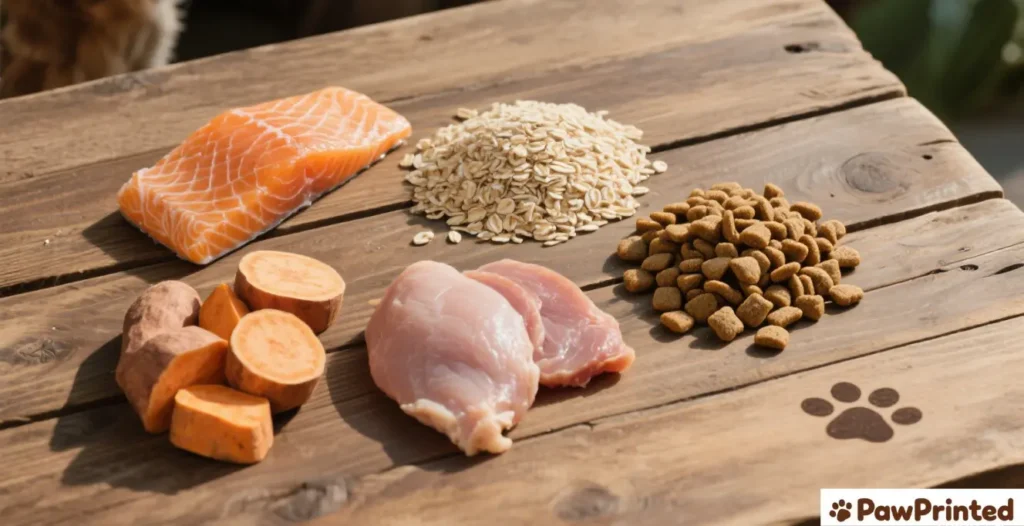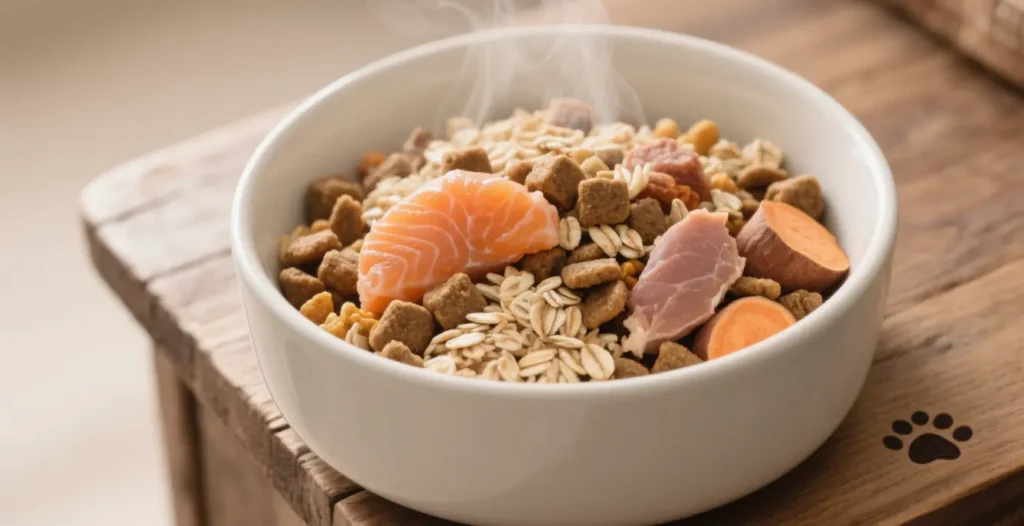A calm belly, smaller stools, less gas — here’s the gentle kibble routine that finally worked for Ethan and the products we keep going back to.
I still remember the 2 a.m. carpet clean-ups. Ethan would wolf down dinner, then an hour later he’d pace, lick his lips, and we’d be outside under the porch light. For weeks, mornings meant soft stools and me second-guessing every ingredient on the bag. I started a food diary, called our vet, and tested portions and proteins. Three patterns kept returning: chicken often worked better than beef, smaller kibble sat easier, and simple formulas (fewer ingredients, predictable fiber) gave his gut a chance to reset. Below is the exact dry-food playbook we built — gentle choices first, then “plan B” options, plus how we transition and troubleshoot.

What Worked for Us (and Why)
The first time Ethan turned his nose up at dinner, it wasn’t because he wasn’t hungry—it was because his stomach had been unsettled for days. Our vet suggested we step back, simplify, and keep notes on every bowl. That’s how we built our short list of dry foods that actually worked for him.
We began with Hill’s Sensitive Stomach & Skin, a steady base that calmed his digestion without sacrificing daily nutrients. The predictable formula was reassuring—every scoop looked the same, and within a week his stools were firmer.
On days he needed more flavor to coax his appetite, we reached for Purina Pro Plan Sensitive Skin & Stomach (salmon & rice). The salmon-first recipe paired well with probiotics and gave him energy for long walks without upsetting his gut.
Later, when we wanted to rule out possible triggers, a turkey limited-ingredient formula in rotation helped confirm that poultry wasn’t the culprit. We also tried a whitefish & potato option during a reset week—it was bland enough to settle him but still nourishing.
For variety without chaos, we sometimes folded in lamb & brown rice recipes in small portions. And whenever we needed something truly predictable and easy to source, Hill’s Sensitive Wet backed us up as a bridge meal.
None of these were “miracle cures.” What worked was the calm rhythm: one change at a time, consistent notes, and staying within this small circle of gentle, vet-approved choices. Ethan’s gut thanked us, and our kitchen finally had peace at dinnertime.
Internal reads that help: See our overall hub for patterns and quick wins: Sensitive Stomach & Diarrhea Hub, plus common triggers explained in Limited Ingredient Dog Food and our Probiotics for Dogs guide. If you’re also debating textures, we compared options in Best Wet Dog Food for Sensitive Stomach.

Red flags — call your vet: black/tarry stool, blood, repeated vomiting, weight loss, lethargy, or diarrhea lasting >48 hours. Puppies, seniors, or dogs on meds need extra caution.
Why dry food for sensitive stomach needs extra care
- Protein & fiber balance: Moderate protein with soluble fiber often yields steadier stools. Rotating away from rich red meats can help.
- Predictable formulas: LID and veterinary-informed recipes reduce “surprise” ingredients that can irritate guts.
- Kibble size & shape: Smaller or more porous kibble can be easier to break down, especially for small breeds.
- Digestive supports: Prebiotics/probiotics and gentle omega-3s can calm the gut lining over time.
Authoritative reading: See nutrition fundamentals at WSAVA and Tufts Cummings Veterinary Nutrition, general GI guidance from the AVMA, and pet-food safety updates via the FDA Center for Veterinary Medicine.

Our simple routine (3–5 steps)
- Pick one gentle base. Start with a simple chicken or salmon option above. Keep everything else the same for 7–10 days.
- Transition slowly. Follow a 7-day ratio (25%→50%→75%→100%). If you need a template, use our Dog Food Transition Guide.
- Log the first 14 days. Note stool score, gas, appetite, morning energy. Tiny changes beat big swings.
- Layer gentle supports (optional). If stools are still soft after a week, consider rotating in probiotics or trying an LID reset.
- Keep a back-up plan. When stress spikes, we swap to salmon-based or LID for 3–5 days, then ease back.

Comparison table (quick pick by scenario)
| Option | Why it helps | Best for |
|---|---|---|
| Hill’s Sensitive Stomach (Chicken) | Balanced chicken + barley with prebiotics; steady stools. | Everyday gentle base |
| Purina Pro Plan Sensitive (Salmon) | Alternate protein; many dogs tolerate salmon + rice well. | Rotation & flare weeks |
| Blue Buffalo Basics LID | Fewer ingredients; single protein minimizes guesswork. | Suspected ingredient triggers |
| Wellness CORE Salmon | Fish-forward, grain-free option for variety. | Dogs doing better grain-free |
| Zignature Trout & Salmon (LID) | Simplified recipe for “reset” periods. | Sensitive or elimination weeks |
| Hill’s Sensitive Small Breed | Smaller kibble, easier chewing and digestion. | Small breeds & picky chewers |
FAQ
ost dogs show changes within 3–7 days if you transition gradually and keep treats minimal. True stability can take 2–3 weeks while the gut adapts. If stools worsen or you see blood, stop and call your vet. Our transition guide has a day-by-day ratio you can follow.
Not universally. Many sensitive dogs do great on rice or barley. Grain-free can help a subset, but start with simple, moderate-fiber recipes first. For ingredient sleuthing, a limited-ingredient approach is more predictable.
They can help during transitions, stress, or after antibiotics. Pick vet-trusted products and give them daily for 2–4 weeks. See our full guide: Probiotics for Dogs.
Try smaller kibble (like Hill’s Sensitive Small Breed), split meals (3–4 mini-meals), and add warm water to release aroma. If texture helps appetite, compare with our gentle wet options and then ease back to kibble.
Immediately for black/tarry stool, blood, repeated vomiting, lethargy, weight loss, or diarrhea lasting >48 hours. Puppies, seniors, or dogs with chronic conditions should call sooner. You can also review general guidance from the AVMA.
Note: If kibble alone isn’t doing the trick during a flare, peek at our gentle textures in Best Wet Dog Food for Sensitive Stomach and use the transition ratios to switch without upsetting the belly.

Wrapping it up
For Ethan, calmer mornings came from doing less, not more: one gentle base kibble, slow transitions, a short list of trusted backups, and patience. If you’re stuck, start with a simple chicken-or-salmon formula, keep a reset food on deck (LID or fish), and track the first 14 days. Your dog’s gut will tell you when you’ve found “the one.”
Light nudge: If you’re undecided, begin with a gentle chicken base and rotate to salmon during stressful weeks — that’s been our steady rhythm.

